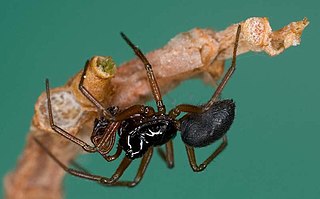Erigone (Ἠριγόνη) may refer to:

Erigoninae are the largest subfamily of sheet weavers (Linyphiidae), which is itself the second largest spider family. In the United States they are known as dwarf spiders, while they are called money spiders in England. The exact taxonomic limits of the subfamily are not yet known.
163 Erigone is an asteroid from the asteroid belt and the namesake of the Erigone family of asteroids that share similar orbital elements and properties. It was discovered by French astronomer Henri Joseph Perrotin on April 26, 1876, and named after one of the two Erigones in Greek mythology.

Ballooning, sometimes called kiting, is a process by which spiders, and some other small invertebrates, move through the air by releasing one or more gossamer threads to catch the wind, causing them to become airborne at the mercy of air currents and electric currents. A 2018 experiment confirmed that electric fields provide enough force to lift spiders in the air. This is primarily used by spiderlings to disperse; however, larger individuals have been observed doing so as well. The spider climbs to a high point and takes a stance with its abdomen to the sky, releasing fine silk threads from its spinneret until it becomes aloft. Journeys achieved vary from a few metres to hundreds of kilometres. Even atmospheric samples collected from balloons at five kilometres altitude and ships mid-ocean have reported spider landings. Mortality is high.

Erigone is a genus of dwarf spiders that was first described by Jean Victoire Audouin in 1826. They are carnivorous, preying on small insects such as psylla and flies. One of the distinctive characters for this genus is the presence of teeth bordering the carapace.
Erigone aletris is a spider species found in the USA, Canada, Scotland and Italy.
Laminacauda dysphorica is a species of sheet weaver found in Bolivia and Peru.
Sauron is a genus of sheet weavers that was first described by K. Y. Eskov & Y. M. Marusik in 1995. They reach a body length of 1.25 to 2 millimetres. The genus name is derived from Sauron, a character in the books of J. R. R. Tolkien.

Trematocephalus is a genus of sheet weavers first described by Friedrich Dahl in 1886.

Hypomma is a genus of dwarf spiders that was first described by David B. Hirst in 1886.
Microctenonyx is a genus of dwarf spiders that was first described by Friedrich Dahl in 1886.

Moebelia is a genus of dwarf spiders that was first described by Friedrich Dahl in 1886. As of May 2019 it contains only three species, found in China, Germany, and Russia: M. berolinensis, M. penicillata, and M. rectangula.
Silometopus elegans is a species of spiders in the family Linyphiidae found in Europe. It was first described by Octavius Pickard-Cambridge in 1873, as Erigone elegans. It was transferred to the genus Silometopus by Eugène Simon in 1884.
Erigone autumnalis is a species of dwarf spiders in the family Linyphiidae. It is found in North and Central America, and it has been introduced to Azores, Europe, United Arab Emirates, and New Caledonia.

Microneta viaria is a species of sheetweb spider in the family Linyphiidae. It is found in North America, Europe, Turkey, North Africa, the Caucasus, a range within Russia, China, Mongolia, Korea, and Japan.

Erigone atra is a species of dwarf spider or money spider, in the family Linyphiidae. It is commonly found in North America, Europe, parts of Russia, Central Asia, China, Mongolia, Korea, and Japan. This spider is one of the most common Erigone spiders. E. atra is an important spider for agriculture, as it preys on pests such as aphids which are commonly found on crops. E. atra spiders are aeronautical spiders, as they travel via ballooning. This technique, sometimes referred to as kiting, allows E. atra spiders to traverse large distances and find new habitats when environmental or human stresses create unfit living environments. E. atra is difficult to differentiate from other congeneric species because of their similar sizes and coloring.
Erigone dentosa is a species of dwarf spider in the family Linyphiidae. It is found in a range from the United States to Guatemala and has been introduced into Belgium.
Erigone dentigera is a species of dwarf spider in the family Linyphiidae. It is found in North America, Europe, Caucasus, and Russia.





